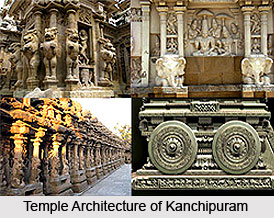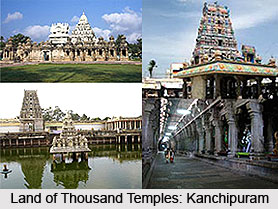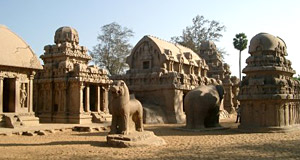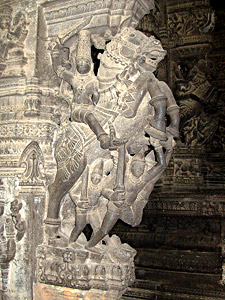 The Pallavas, Cholas, Vijayanagar rulers, Muhammadan Kings, and also the British before Independence administered the district Kanchipuram. Kancheepuram was the capital of the Thondaimandalam. This Thondaimandalam was an ancient division of Tamil country comprising roughly the present districts of Kancheepuram, Chennai, Tiruvallur, Vellore and Tiruvannamalai.
The Pallavas, Cholas, Vijayanagar rulers, Muhammadan Kings, and also the British before Independence administered the district Kanchipuram. Kancheepuram was the capital of the Thondaimandalam. This Thondaimandalam was an ancient division of Tamil country comprising roughly the present districts of Kancheepuram, Chennai, Tiruvallur, Vellore and Tiruvannamalai.
In 1788 district Collector was appointed for the first time. This is regarded as the major breakthrough in the district administration. The district was split up into two divisions, Northern and Southern and placed under two Collectors as well. The names of the Collectors during 1790`s were Clerk and Balfour.
During the time 1794-1799, the posts of Sharistadars were created under the control of the Collector. Clerks were also appointed to assist the Sharistadars. The famous Madurantakam and Uthiramerur tanks were also created.
By the time Karunguzhi became the headquarters of the district. It remained like this up to 1859. During the time of 1825-1835, the Kancheepuram serves as district headquarters when Karunguzhi was shifted to `Home Garden` Saidapettai for a short spell. From 1859 to 1968 the Collector`s office was located in Saidapettai and with effect from 1st July 1968 Kancheepuram became the district headquarters.
 In 1900 the position of the district administration was like this, the Collector having his headquarters at Saidapettai, and a Sub-Collector and two General Deputy Collectors, six Tahsildars assisted it for six Taluks and five Deputy Tahsildars for five sub taluks. The Sub-Collector and the General Deputy Collectors were the heads of the revenue divisions of Chengalpattu, comprising Chengalpattu, Madurantakam and Kancheepuram Taluks; Saidapettai comprising Saidapettai and Ponneri Taluks and Tiruvallur comprising the lone Taluk of Tiruvallur.
In 1900 the position of the district administration was like this, the Collector having his headquarters at Saidapettai, and a Sub-Collector and two General Deputy Collectors, six Tahsildars assisted it for six Taluks and five Deputy Tahsildars for five sub taluks. The Sub-Collector and the General Deputy Collectors were the heads of the revenue divisions of Chengalpattu, comprising Chengalpattu, Madurantakam and Kancheepuram Taluks; Saidapettai comprising Saidapettai and Ponneri Taluks and Tiruvallur comprising the lone Taluk of Tiruvallur.
Later in 1911 when Sriperumbudur sub-taluk was upgraded as a full-fledged taluk, the fourth revenue division was formed with headquarters at Kancheepuram comprising Kancheepuram and Sriperumbudur Taluks.
In 1st July 1997, the Chengalpattu-MGR district has been splitted into two as Kancheepuram and Tiruvallur Districts. On the same day, Tirukalukundram Taluk demarcated by bifurcating the Chengalpattu Taluk. Thus the new Kancheepuram District is formed on 1st July 1997 comprising of 8 Taluks, via, Kancheepuram, Sriperumbudur, Uthiramerur, Chengalpattu, Tambaram, Tirukalukundram, Madrandakam and Cheyyur.
Kancheepuram is derived from its English name Conjeevaram. Like all ancient cities, Kancheepuram is also situated on the banks of a river, Vegavati.
 The city was the capital of the Early Cholas as far back as the 2nd century BC and a Pallava capital between the 6th and 8th centuries. It is surrounded by the historic places like Mamallapuram, Thiruvannamalai, Vellore, Sholingar, Thiruthani and Thirupathi. The sculptures in Mamallapuram town are famous for Pallava`s architectures. The architectural and religious grandeur as well as value have been added by the successive dynasties from Pallavas to Vijayanagar kings. This happened in long one thousand five hundred years.
The city was the capital of the Early Cholas as far back as the 2nd century BC and a Pallava capital between the 6th and 8th centuries. It is surrounded by the historic places like Mamallapuram, Thiruvannamalai, Vellore, Sholingar, Thiruthani and Thirupathi. The sculptures in Mamallapuram town are famous for Pallava`s architectures. The architectural and religious grandeur as well as value have been added by the successive dynasties from Pallavas to Vijayanagar kings. This happened in long one thousand five hundred years.
According to Kalidasa, the famous ancient poet, the district is said to be the best among the cities i.e. Nagareshu Kanchi. It can be compared with just as Jati or jasmine is the sweetest amongst the flowers, Rambha the most beautiful amongst women and Grihasthasrama the most ideal amongst the four asramas of human life.
From ancient days great scholars like Gautam Buddha has visited the place. Yuan Chwang, the great Chinese traveler also visited the city in the 7th century. Regarding learning, Kanchi stood second while Banaras is in the first position. The history of Kanchi can be traced back to several centuries also before the advent of the Christian era.
The place finds its name in Patanjali`s Mahabhashya written in the second century B.C. The description of the district can also get from the Manimekalai, the famous Tamil classic and Perumpanattu Padai, a great Tamil poetical work. Pathupattu, one of the sangam literatures reads that the king Thondaiman Ilandirayan ruled this town around 2500 years ago.
 From the 3rd to the 9th century A.D. Kanchi was the capital of the Pallavas who ruled over the territory extending from the river Krishna in the north to the river Kaveri in the south. The Pallavas fortified the city with ramparts, moats, etc., also with wide and well laid out roads and fine temples.
From the 3rd to the 9th century A.D. Kanchi was the capital of the Pallavas who ruled over the territory extending from the river Krishna in the north to the river Kaveri in the south. The Pallavas fortified the city with ramparts, moats, etc., also with wide and well laid out roads and fine temples.
The Cholas ruled this town from 10th century to 13th century while Kings of Vijayanagara dynasty ruled from 14th century to 17th century. There are some famous temples present in the city. The British Viceroy Robert clive, who is responsible for the British Ruling in India had exclaimed the architectural techniques of Varadharaja perumal temple and presented a fabulous jewelry to this temple.
Kanchi was a major seat of Tamil learning as well as an important place of pilgrimage for Buddhists, Jains and Hindus.
The City Of Thousand Temples:
Ancient Kanchipuram is also known as the city of thousand temples. It is one of the seven most sacred pilgrim centers namely Ayodya, Madura, Maya, Kasi, Kanchi, Avanthi, Duvaragai for the Hindus. Kanchipuram owns 108 temples dedicated to Siva and 18 to Vishnu. Besides these the district also has other temples, mosques, churches and Adi Shankara Mutt.
Temple festivals are held throughout the year and apart from the temple car i.e. ratha festivals which are held in January, April and May. There are other days when the idols in the temples are taken out in procession on their respective vahanas or vehicles.






